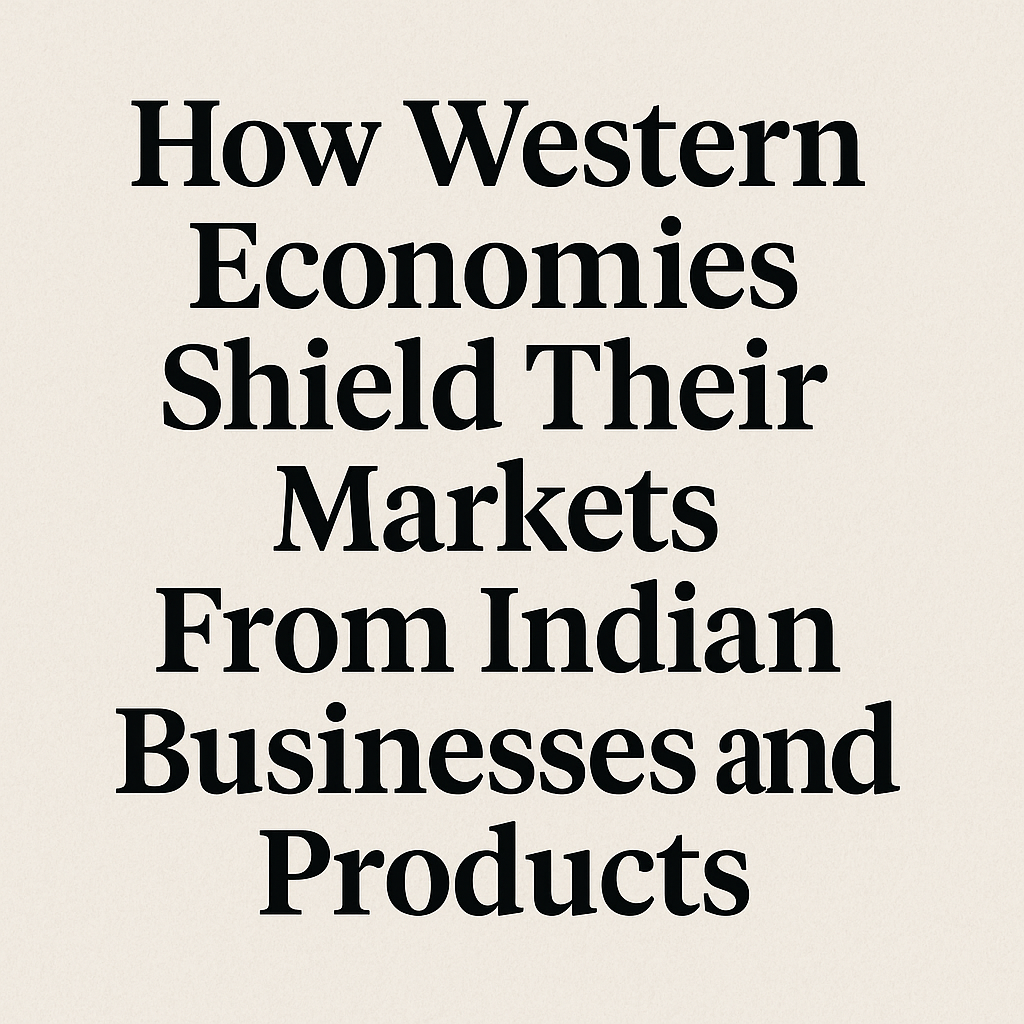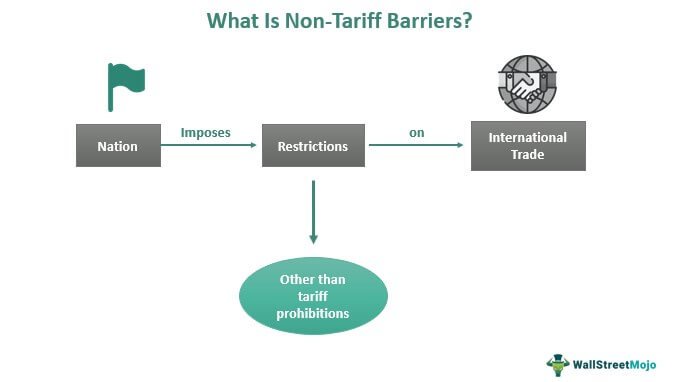🌐 The Global Trade Illusion: Free for Some, Barriers for Others
In an increasingly interconnected world, the promise of free trade often rings hollow for businesses from developing countries like India. While globalization encourages open markets, Western developed economies have systematically created intricate mechanisms to protect their industries from being overwhelmed by competitive, low-cost imports. Indian products — from textiles and steel to pharmaceuticals and agro-exports — frequently find themselves facing visible and invisible barriers.
This blog dives deep into how these barriers work, why they’re used, and how they impact India’s global trade aspirations.

🔹 1. Tariffs and Import Taxes: The First Line of Defense
Tariffs are among the oldest and most straightforward protectionist tools. Western nations impose import duties to make foreign goods more expensive and less attractive compared to domestic alternatives.
Case in Point: India vs. US Tariff Spats
The United States has, at various times, threatened or imposed high tariffs on Indian exports such as textiles, aluminium, and agriculture products. These are not just economic tools, but also strategic levers used during trade negotiations.
For instance, in 2025, the US considered 15–25% tariffs on select Indian imports citing trade imbalances and IP-related disputes. This immediately raised alarm within India’s export-dependent sectors.
❓ Why Tariffs Hurt
Tariffs directly increase the cost of Indian goods abroad, making them less competitive. Indian businesses then either lose out on market share or reduce margins to stay competitive.
🔹 2. Anti-Dumping and Countervailing Duties
Western nations often accuse exporters from India and other developing countries of “dumping” — selling goods below cost to gain market share.
To prevent this, anti-dumping duties are imposed to offset the low pricing. Additionally, if a country subsidizes its exporters, countervailing duties are added to neutralize that advantage.
💰 The Steel & Chemical Example
Indian steel, chemicals, and textiles are frequent targets of anti-dumping investigations by the EU and US. Despite WTO norms, these duties are often slapped based on protectionist instincts rather than hard evidence.
These duties can range from 10% to over 100%, essentially pricing Indian goods out of the market.
🔹 3. Non-Tariff Barriers: The Hidden Roadblocks
Even when tariffs are reduced due to trade agreements, non-tariff barriers (NTBs) often take their place. These are subtle yet highly effective tools.
🔢 Examples Include:
- Technical regulations: Complex and stringent standards on labeling, safety, and certification.
- Sanitary and Phytosanitary (SPS) measures: Particularly in food exports.
- Rules of origin: Demanding detailed proof of where goods were made.
- Bureaucratic delays: Customs red tape, documentation errors, pre-shipment inspection demands.
These measures can delay, deter, or inflate the cost of Indian exports significantly.

🚗 Auto and Electronics Case
Many Indian auto parts exporters face rejection or expensive retesting under European or North American safety standards. The result? Reduced competitiveness despite cost advantage.
🔹 4. Strategic Use of Safeguards and Quotas
Even under Free Trade Agreements (FTAs), Western economies often build in safeguard mechanisms to protect sensitive sectors from sudden import surges.
UK’s Steel Quota Strategy
In 2025, Britain imposed strict steel import quotas on countries like Vietnam and South Korea. Though India wasn’t directly named, the precedent is clear: if imports rise too fast, caps will follow.
EU’s Carbon Border Tax (CBAM)
Under the guise of environmental protection, CBAM taxes products from countries with weaker climate norms. This impacts Indian cement, aluminium, and energy-intensive exports — increasing their landed cost.
🔹 5. Trade Agreements: Friendly Pacts with Embedded Protections
FTAs often appear liberal on the surface but contain clauses that allow quick retaliation, quota impositions, or prolonged tariff phase-outs for sensitive sectors.
FTA Caution
The recently signed UK-India FTA allows gradual liberalization but includes strict protections for British dairy, textiles, and auto industries. Indian players may gain access, but only within controlled limits.
❓ The Illusion of Reciprocity
While India grants wide access to foreign brands in retail, banking, and e-commerce, similar reciprocity in pharma, IT, or agro-products is often restricted abroad.
🔹 6. Local Content and Procurement Rules
Many Western governments reserve government contracts and public procurement projects for domestic companies or require high local content.
The Buy American Act
The US restricts federal contracts to American-made goods unless waived. This makes it nearly impossible for Indian companies to win infrastructure or defense contracts despite competitive pricing.
EU Localism
Countries like France and Germany insist on sourcing a majority of supplies from local or EU-based suppliers. Even Indian pharma firms with EU approvals struggle to participate in tenders.
🔹 7. Cultural Protectionism & Informal Barriers
Western economies also safeguard their cultural and creative industries through content quotas and subsidies:
- France mandates 40% local content on radio/TV.
- Many countries subsidize local media, arts, and publishing.
This creates soft protectionism, limiting market access for Indian films, books, or streaming content, even when demand exists.
🌎 8. Sustainability and ESG Compliance
Newer trade standards are embedding environmental, social, and governance (ESG) requirements.
- Apparel, leather, and jewellery exports now face scrutiny on water usage, labor rights, and emissions.
- Many Indian exporters face rejections or devaluation based on ESG audits by European buyers.
While ESG compliance is important, the cost of compliance is often unaffordable for small Indian businesses, creating a barrier in disguise.
📊 Summary Table: How the West Protects Its Markets
| Tool | Impact on Indian Exports |
|---|---|
| Tariffs | Increases product cost, reduces competitiveness |
| Anti-dumping/Countervailing Duties | Penalizes pricing or subsidies, restricts access |
| Non-Tariff Barriers (NTBs) | Creates regulatory complexity, adds cost and delay |
| Import Quotas & Safeguards | Capping growth of exports, especially in steel, food, textiles |
| Local Procurement Rules | Limits access to government contracts, favors local players |
| FTA Clauses | Delays or limits tariff reduction; builds in retaliation tools |
| ESG & Sustainability Norms | Adds compliance cost, restricts access to green-sensitive sectors |
| Cultural Quotas | Limits media, arts, and entertainment exports |
🌍 Global Trends: Protectionism with a Liberal Face
The global trade system today is not truly free. It is managed globalization, where Western nations open up sectors they dominate (tech, finance, luxury) and protect those they fear competition in (manufacturing, agriculture, culture).
The World Trade Organization (WTO) rules are often toothless when it comes to enforcing fair access for developing countries.
The rise of neo-protectionism is visible in:
- US tariffs on Chinese and Indian products.
- UK steel quotas.
- EU’s Carbon Border Adjustment.
- “Buy American” campaigns.
✅ Conclusion: Competing in an Uneven Arena
Indian businesses enter Western markets at a disadvantage not because of product quality or ambition, but because of a multi-layered system of invisible walls. These range from tariffs and quotas to ESG mandates and procurement preferences.
While India must continue to fight these barriers through trade diplomacy, WTO challenges, and bilateral negotiations, the real strategy lies in:
- Investing in quality and branding.
- Understanding global compliance standards.
- Building scale and partnerships.
Protectionism may remain, but with the right preparation, Indian businesses can still thrive — even in guarded markets.
The journey ahead isn’t easy. But it’s navigable, and the time to prepare is now.
FOR MORE BLOGS – beyondthepunchlines.com

 Add to favorites
Add to favorites








